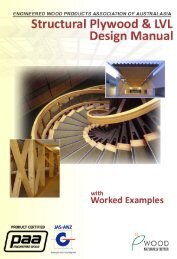Facts About Particleboard and MDF - Engineered Wood Products ...
Facts About Particleboard and MDF - Engineered Wood Products ...
Facts About Particleboard and MDF - Engineered Wood Products ...
Create successful ePaper yourself
Turn your PDF publications into a flip-book with our unique Google optimized e-Paper software.
Thermal Properties<br />
The thermal conductivity of <strong>MDF</strong> varies slightly with thickness with the usual range being 0.05 - 0.08<br />
kcal/mh°C (0.12 - 0.15 W/m°K).<br />
Like natural timber, <strong>MDF</strong> has a low thermal capacity. With the normal range of temperature variation, <strong>MDF</strong> is<br />
dimensionally stable <strong>and</strong> its strength unaffected.<br />
Acoustic Properties<br />
Sound transmission loss is a property that depends greatly on the building element <strong>and</strong> its method of<br />
installation. However, as a general figure, <strong>MDF</strong> of a thickness of 16 mm <strong>and</strong> thicker should achieve a sound<br />
transmission class of STC - 29.<br />
Fire Behaviour<br />
Fire Resistance<br />
Fire resistance relates to the period for which an element of construction will resist the passage of flame,<br />
remain free from collapse <strong>and</strong> insulate against an excessive temperature rise on the unexposed face. The<br />
property relates to a building element <strong>and</strong> its details of construction, rather than a particular material. <strong>MDF</strong><br />
reacts generally to fire like natural timber. The rate of burning is similar <strong>and</strong> it does not shatter or<br />
delaminate.<br />
Combustibility<br />
<strong>MDF</strong> is combustible. The degree of combustibility depends on type <strong>and</strong> density of the board. As with timber,<br />
burning will be limited by the formation of charcoal on the surface but shrinkage will tend to cause failure at<br />
joints, unless proper consideration has been given to design.<br />
Fire Hazard<br />
Fire hazard refers to the surface burning characteristics of a material <strong>and</strong> indicates whether a material will<br />
allow a fire to spread quickly. Smoke developed is also part of the hazard assessment.<br />
Fire hazard is measured by procedures laid down in AS 1530 Part 3 <strong>and</strong> is expressed as indices. Typical results<br />
for <strong>MDF</strong> are:<br />
Index<br />
Range<br />
Ignitability 14 0 - 20<br />
Spread of Flame 8 0 - 10<br />
Heat Evolved 7 0 - 10<br />
Smoke Developed 4 0 - 10<br />
Specific building regulations indicate where materials with specific early fire hazard indices can be used.<br />
21

















